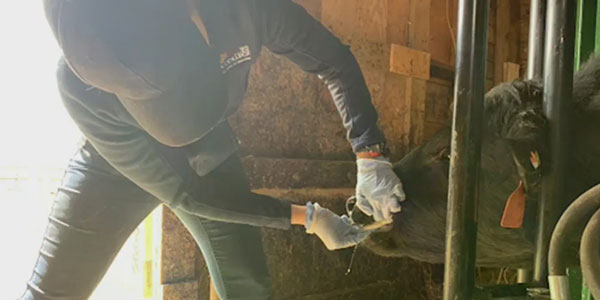The central focus of this project was addressing the challenge posed by observed excitable reactivity in cattle during routine handling, a factor that often results in injuries to both handlers and animals. In the first year, 200 Angus crossbred heifers, aged 13-14 months were enrolled. Prior to the breeding season, all heifers were ranked by body condition score and were subsequently divided into four equivalent groups. These groups were housed in distinct feedlot pens (50 heifers per pen per treatment) for approximately four weeks, with two groups assigned to each treatment — acclimation or control.

Dr. Gellatly collects saliva samples from heifers using cotton swabs to further salivary cortisol concentration assessment.
The acclimation process combined feed reinforcement and non-aversive successive handling techniques, aiming to reduce stress levels towards handlers and handling facilities. Briefly, prior to breeding and for five alternate days, a familiar handler entered the acclimated treatment pens. The handler adopted a soft-spoken approach while pail-feeding the heifers with a small amount of mixed barley (approximately 100 grams per heifer). This method aimed to create, under animals’ perspective, a positive association of humans. Subsequently, these heifers were guided through the chute on three separate days (adopting low-stress handling techniques and without restraint), receiving identical feed rewards immediately after handling. Conversely, heifers in the control groups were solely fed by a feed truck without any human interaction and were not exposed to handling acclimation procedures before breeding.
During the second year, a new group of 122 Angus crossbred heifers, aged 13-14 months, underwent an identical evaluation to the one conducted in the 2020 study, ensuring consistency in experimental procedures.